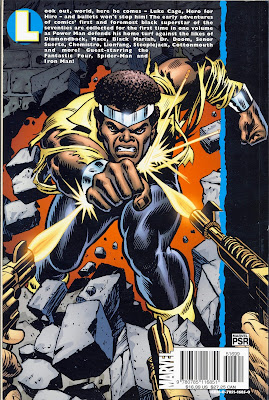Nowadays original copies of the first few issues of 'Luke Cage' (later renamed 'Power Man') comics go for steep prices, so the most economical way to take in the series is through the black and white 'Marvel Essentials' paperback, which collects the first 27 issues, from June 1972 through October 1975.
While I remember seeing the Luke Cage issues on the stands in the early 70s, I was never motivated to purchase any, mainly because the villains were so cheesy. Instead of the 'cosmic' adversaries faced by the Fantastic Four, Thor, or the Avengers, Luke Cage - like Daredevil at this time in his publishing history - was pretty much left to fight third-tier nobodies like 'Mr Death', 'The Steeplejack', and 'Chemistro', among others:
Although on rare occasions, a genuine marquee bad guy would make an appearance:
My favorite of these oddball villains was one 'Black Mariah', an obese woman who did not take any jive from her fellow criminals, much less Luke Cage:
While no sellout, occasionally Luke had to put the smackdown on those 'radical' soul brothers who were pushing him to join the fight against 'The Man' :
George Tuska's artwork on the series was quite good.Tuska always made Luke's battles look like they were genuinely physical, bruising affairs:
For a series that featured one of the first major black comic book heroes, portraying Luke in situations with some degree of social relevance did take place, but more rarely than one might think.
In a two-parter, Luke takes on a drug dealer named Cottonmouth, who is peddling slow death to the impoverished black folk of inner-city New York:
In another episode, Luke and his friend D.W. go West to seek Luke's estranged girlfriend; en route, they come across a prototype 'planned community' where they aren't exactly welcome:
Compared to the violent street culture that features so prominently in contemporary rap culture, these comics will seem restrained, if not tame to modern readers (Luke likes to shout 'Christmas !' when attacked, but this was after all a Code book).




















































